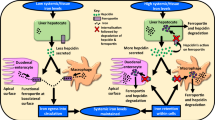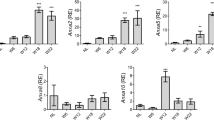Abstract
The long pentraxin (PTX) 3 and the neuronal pentraxin (NPTX) 2 has been found to exert pleiotropic roles in cancers due to their action in inflammation. However, the accurate clinical significance of PTX3 and NPTX2 in hepatocellular carcinoma (HCC), one of the commonest cancers in the world has not been well-defined. The aim of the study was to analyze the expression profile of PTX3 and NPTX2 in liver biopsies of HCV-positive HCC patients (liver recipients, LR, n = 14, age 59.4 ± 1.8 years) undergoing liver transplantation and in donors (LD, n = 14, age 62.1 ± 17.3 years), trying both to identify them as predictive biomarkers of clinical liver severity in HCC patients and to understand if they were mutually substitutable. The PTX3 and NPTX2 transcripts were significantly up regulated in HCC tissues (p = 0.004 and p = 0.02 LD vs. LR, respectively). Dividing patients following MELD score, PTX3 expression increased as a function of liver disease severity, while this trend was not observed for NPTX2, which mRNA level increased similarly in both MELD group, reaching the significance only in patients with MELD score < 9 (p = 0.01). A positive correlation was found between PTX3 and NPTX2 expression (p = 0.001; r = 0.69). This is the first study that concerns PTX3 and NPTX2 as a function of clinical severity from which emerged that both of them are unequivocally involved in HCC, but only PTX3 could be considered a staging marker in these HCV-related HCC patients, unlike NPTX2, which could only play a role as an inflammatory marker.



Similar content being viewed by others
References
Garlanda C, Bottazzi B, Bastone A, et al. Pentraxins at the crossroads between innate immunity, inflammation, matrix deposition, and female fertility. Ann Rev Immunol. 2005;23:337–66.
Whitehead AS, Zahedi K, Rits M, Mortensen RF, Lelias JM. Mouse C-reactive protein. generation of cDNA clones, structural analysis and induction of mRNA during inflammation. Biochem J. 1990;266:283–90.
Dowton SB, McGrew SD. Rat serum amyloid P component. Biochem J. 1990;270:571–85.
Breviarios F, d’Aniellos EM, Golay J, et al. Interleukin-1-inducible genes in endothelial cells. J Biol Chem. 1992;267:22190–7.
Lee GW, Lee TH, Vilcek J. TSG-14, a tumor necrosis factor- and IL-1-inducible protein, is a novel member of the pentraxin family of acute phase proteins. J Immunol. 1993;150:1804–12.
Schlimgen AK, Helms JA, Vogel H, Perin MS. Neuronal pentraxin, a secreted protein with homology to acute phase proteins of the immune system. Neuron. 1995;14:519–26.
Hsu YC, Perin MS. Human neuronal pentraxin II (NPTX2): conservation, genomic structure, and chromosomal localization. Genomics. 1995;28:220–7.
Tsui CC, Copeland NG, Gilbert DJ, Jenkins NA, Barnes C, Worley PF. Narp, a novel member of the pentraxin family, promotes neurite outgrowth and is dynamically regulated by neuronal activity. J Neurosci. 1996;16:2463–78.
Lee SJ, Wei M, Zhang C, et al. Presynaptic neuronal pentraxin receptor organizes excitatory and inhibitory synapses. J Neurosci. 2017;37:1062–80.
Schwalbe RA, Dahlbäck B, Coe JE, Nelsestuen GL. Pentraxin family of proteins interact specifically with phosphorylcholine and/or phosphorylethanolamine. Biochemistry. 1992;31:4907–15.
Bonacina F, Baragetti A, Catapano AL, et al. Long pentraxin 3: experimental and clinical relevance in cardiovascular diseases. Mediators Inflamm. 2013;2013:725102.
Bottazzi B, Vouret-Craviari V, Bastone A, et al. Multimer formation and ligand recognition by the long pentraxin PTX3. Similarities and differences with the short pentraxins C-reactive protein and serum amyloid P component. J Biol Chem. 1997;272:32817–23.
Bottazzi B, Inforzato A, Messa M, Barbagallo M, Magrini E, Garlanda C, Mantovani A. The pentraxins PTX3 and SAP in innate immunity, regulation of inflammation and tissue remodelling. J Hepatol. 2016;64:1416–27.
Doni A, Stravalaci M, Inforzato A, et al. The Long Pentraxin PTX3 as a Link Between Innate Immunity, Tissue Remodeling, and Cancer. Front Immunol. 2019;10:712.
Chorny A, Casas-Recasens S, Sintes J, et al. The soluble pattern recognition receptor PTX3 links humoral innate and adaptive immune responses by helping marginal zone B cells. J Exp Med. 2016;213:2167–85.
Chang WC, Wu SL, Huang WC, et al. PTX3 gene activation in EGF-induced head and neck cancer cell metastasis. Oncotarget. 2015;6:7741–57.
Choi B, Lee EJ, Park YS, et al. Pentraxin-3 silencing suppresses gastric cancer-related inflammation by inhibiting chemotactic migration of macrophages. Anticancer Res. 2015;35:2663–8.
Choi B, Lee EJ, Shin MK, et al. Upregulation of brain-derived neurotrophic factor in advanced gastric cancer contributes to bone metastatic osteolysis by inducing long pentraxin 3. Oncotarget. 2016;7:55506–17.
Choi B, Lee EJ, Song DH, et al. Elevated Pentraxin 3 in bone metastatic breast cancer is correlated with osteolytic function. Oncotarget. 2014;5:481–92.
Locatelli M, Ferrero S, Martinelli Boneschi F, et al. The long pentraxin PTX3 as a correlate of cancer-related inflammation and prognosis of malignancy in gliomas. J Neuroimmunol. 2013;260:99–106.
Willeke F, Assad A, Findeisen P, et al. Overexpression of a member of the pentraxin family (PTX3) in human soft tissue liposarcoma. Eur J Cancer. 2006;42:2639–46.
Stallone G, Cormio L, Netti GS, et al. Pentraxin 3: a novel biomarker for predicting progression from prostatic inflammation to prostate cancer. Cancer Res. 2014;74:4230–8.
Diamandis EP, Goodglick L, Planque C, Thornquist MD. Pentraxin-3 is a novel biomarker of lung carcinoma. Clin Cancer Res. 2011;17:2395–9.
Ronca R, Giacomini A, Di Salle E, et al. Long-Pentraxin 3 derivative as a small-molecule fgf trap for cancer therapy. Cancer Cell. 2015;28:225–39.
Wang JX, He YL, Zhu ST, Yang S, Zhang ST. Aberrant methylation of the 3q25 tumor suppressor gene PTX3 in human esophageal squamous cell carcinoma. World J Gastroenterol. 2011;17:4225–30.
Bartolini A, Di Paolo D, Noghero A, et al. The neuronal pentraxin-2 pathway is an unrecognized target in human neuroblastoma, which also offers prognostic value in patients. Cancer Res. 2015;75:4265–71.
von Roemeling CA, Radisky DC, Marlow LA, et al. Neuronal pentraxin 2 supports clear cell renal cell carcinoma by activating the AMPA-selective glutamate receptor-4. Cancer Res. 2014;74:4796–810.
Song T, Wang C, Guo C, Liu Q, Zheng X. Pentraxin 3 overexpression accelerated tumor metastasis and indicated poor prognosis in hepatocellular carcinoma via driving epithelial-mesenchymal transition. J Cancer. 2018;9:2650–8.
Feder S, Haberl EM, Spirk M, Weiss TS, Wiest R, Buechler C. Pentraxin-3 is not related to disease severity in cirrhosis and hepatocellular carcinoma patients. Clin Exp Med. 2020;20:289–97.
Petruzziello A. Epidemiology of hepatitis B virus (HBV) and hepatitis C virus (HCV) related hepatocellular carcinoma. Open Virol J. 2018;12:26–32.
Mantovani A, Allavena P, Sica A, Balkwill F. Cancer-related inflammation. Nature. 2008;454:436–44.
Cabiati M, Gaggini M, De Simone P, Basta G, Gastaldelli A, Del Ry S. Assessment of RANKL/RANK/osteoprotegerin system expression in patients with hepatocellular carcinoma. Minerva Endocrinol. 2020. https://doi.org/10.23736/S0391-1977.20.03163-6.
Cabiati M, Gaggini M, Cesare MM, et al. Osteopontin in hepatocellular carcinoma: A possible biomarker for diagnosis and follow-up. Cytokine. 2017;99:59–65.
Gaggini M, Cabiati M, Del Turco S, et al. Increased FNDC5/Irisin expression in human hepatocellular carcinoma. Peptides. 2017;88:62–6.
Wiesner RH, Edwards E, Freeman RA, et al. Model for end-stage liver disease (MELD) and allocation of donor livers. Gastroenterology. 2003;124:91–6.
Bustin SA, Benes V, Garson JA, et al. The MIQE guidelines: minimum information for publication of quantitative real-time PCR experiments. Clin Chem. 2009;55:611–22.
De Simone P, Crocetti L, Pezzati D, et al. Efficacy and safety of combination therapy with everolimus and sorafenib for recurrence of hepatocellular carcinoma after liver transplantation. Transplant Proc. 2014;46:241–4.
Manfredi AA, Rovere-Querini P, Bottazzi B, Garlanda C, Mantovani A. Pentraxins, humoral innate immunity and tissue injury. Curr Opin Immunol. 2008;20:538–44.
Ortega-Hernandez OD, Bassi N, Shoenfeld Y, Anaya JM. The Long Pentraxin 3 and its role in autoimmunity. Semin Arthritis Rheum. 2009;39:38–54.
Rajkovic I, Denes A, Allan SM, Pinteaux E. Emerging roles of the acute phase protein pentraxin-3 during central nervous system disorders. J Neuroimmunol. 2016;292:27–33.
Carmo RF, Aroucha D, Vasconcelos LR, Pereira LM, Moura P, Cavalcanti MS. Genetic variation in PTX3 and plasma levels associated with hepatocellular carcinoma in patients with HCV. J Viral Hepat. 2016;23:116–22.
Xu C, Tian G, Jiang C, et al. NPTX2 promotes colorectal cancer growth and liver metastasis by the activation of the canonical Wnt/ β -catenin pathway via FZD6. Cell Death Dis. 2019;10:217.
Narciso-Schiavon JL, Pereira JG, Silva TE, et al. Circulating levels of pentraxin-3 (PTX3) in patients with liver cirrhosis. Ann Hepatol. 2017;16:780–7.
Mantovani A, Ponzetta A, Inforzato A, Jaillon S. Innate immunity, inflammation and tumour progression: double-edged swords. J Intern Med. 2019;285:524–32.
Ying TH, Lee CH, Chiou HL, et al. Knockdown of Pentraxin 3 suppresses tumorigenicity and metastasis of human cervical cancer cells. Sci Rep. 2016;6:29385.
Funding
This work was supported by “INTEROMICS FLAGSHIP PROJECT” (Metabolomics identification of prognostic and diagnostic biomarkers of hepatocellular carcinoma), supported by the MUR (Italian Ministry of Education, University and Research) and coordinated by the CNR (National Research Council).
Author information
Authors and Affiliations
Contributions
All authors contributed to the study conception and design. Conceptualization, data curation, formal analysis were done by Manuela Cabiati, Silvia Del Ry. Methodology was done by Silvia Del Ry, Manuela Cabiati and Melania Gaggini. Patient enrolment was done by Paolo De Simone. Writing—original draft was done by Manuela Cabiati and Silvia Del Ry. Writing—review & editing was done by Silvia Del Ry and Melania Gaggini. All authors read and approved the final manuscript.
Corresponding author
Ethics declarations
Conflict of interest
The authors declare that there is no conflict of interest regarding the publication of this article.
Consent for publication
All authors gave their consent for this paper publication.
Ethics approval and consent to participate
The study was carried out in compliance with the principles set forth in the 2008 Seoul revision of the declaration of Helsinki. All protocols of this study were approved by the Institutional Ethics Committee, according to the Code of Ethics of the World Medical Association (declaration of Helsinki) for experiments involving human subjects. All patients enrolled gave their consent to be included in the study.
Additional information
Publisher's Note
Springer Nature remains neutral with regard to jurisdictional claims in published maps and institutional affiliations.
Rights and permissions
About this article
Cite this article
Cabiati, M., Gaggini, M., De Simone, P. et al. Do pentraxin 3 and neural pentraxin 2 have different facet function in hepatocellular carcinoma?. Clin Exp Med 21, 555–562 (2021). https://doi.org/10.1007/s10238-021-00714-y
Received:
Accepted:
Published:
Issue Date:
DOI: https://doi.org/10.1007/s10238-021-00714-y




